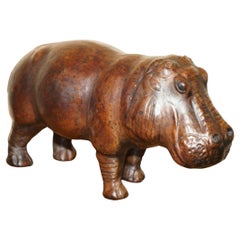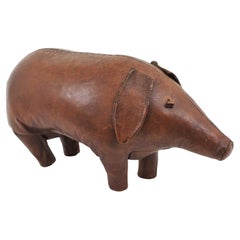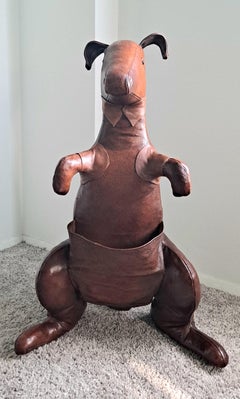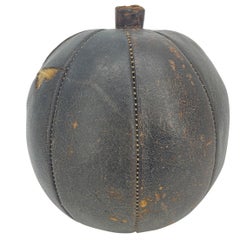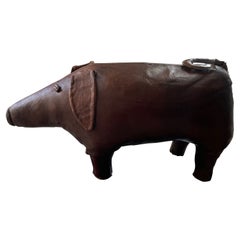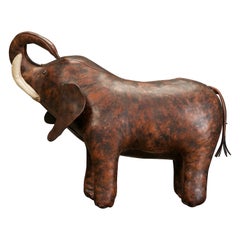Dimitri Omersa On Sale
Small Infant Liberty's London Omersa Brown Leather Hippopotamus Footstool
By Liberty of London, Dimitri Omersa
Located in West Sussex, Pulborough
We are delighted to offer for sale this absolutely sublime very rare and original 1930’s Liberty’s London Omersa brown leather land dyed infant Hippo stool or footstool with original...
Category
Vintage 1930s European Art Deco Animal Sculptures
Materials
Leather
$1,481 Sale Price
20% Off
H 6.89 in W 5.12 in D 12.6 in
Pig Stool by Dimitri Omersa in Brown Leather, 1950s
By Dimitri Omersa, Liberty of London
Located in Barcelona, ES
Handsome handmade leather pig footstool / ottoman designed and manufactured at the 1950s by Dimitri Omersa for Liberty of London.
Pig ottoman first made in the 1930's for Liberty '...
Category
Mid-20th Century British Mid-Century Modern Footstools
Materials
Leather
$2,822 Sale Price
20% Off
H 13 in W 25.2 in D 9.85 in
leather Kangaroo magazine Holder by Dimitri Omersa
By Dimitri Omersa
Located in Los Angeles, CA
Dimitri Omersa has been quietly crafting unique leather animal foot stools and magazine holders .Dimitry continue to use traditional methods of craftsmanship and the finest raw ma...
Category
Vintage 1960s English Mid-Century Modern Magazine Racks and Stands
Materials
Leather
$2,240 Sale Price
30% Off
H 33.5 in W 23 in D 30.5 in
Abercrombie & Fitch Hand-Stitched Leather Pumpkin by Omersa & Company
By Abercrombie & Fitch, Dimitri Omersa
Located in Haddonfield, NJ
Mid-Century Modern Abercrombie & Fitch hand-stitched leather pumpkin by Omersa & Company. The wide selection of leather items designed by Dimitri Omersa were used for display and foo...
Category
Mid-20th Century Spanish Mid-Century Modern Sports Equipment and Memorab...
Materials
Leather
$360 Sale Price
71% Off
H 8.5 in Dm 8 in
Recent Sales
Liberty 's Ottoman Leather Pig by Dimitri Omersa
By Dimitri Omersa
Located in Brussels, BE
Pig ottoman first made in the 1930's for Liberty 's London during decades and later for Abercrombie & Fitch.
By Dimitri Omersa, United Kingdom.
Category
Mid-20th Century British Arts and Crafts Ottomans and Poufs
Materials
Leather, Wood
Leather Elephant Stool by Dimitri Omersa for Abercrombie & Fitch, c 1963, Signed
By Dimitri Omersa, Abercrombie & Fitch
Located in Los Angeles, CA
A wonderful collectors example of an original leather elephant footstool by Dimitri Omersa for Abercrombie and Fitch, circa 1963. This example is signed with the circle 'A&F CO' embo...
Category
Vintage 1960s English Mid-Century Modern Footstools
Materials
Leather
H 16 in W 20 in D 11 in
20th Century Brown Leather Model of a Rhinoceros by Dimitri Omersa
By Dimitri Omersa
Located in Petworth,West Sussex, GB
A 1970's Rhinoceros trophy by Dimitri Omersa in brown havana coloured leather in very good condition including hanging bracket. Great colour and patina throughout. Free delivery for ...
Category
Late 20th Century British Mid-Century Modern Animal Sculptures
Materials
Leather
Large 33" Leather Rhino Stool by Dimitri Omersa for Abercrombie & Fitch
By Dimitri Omersa, Abercrombie & Fitch
Located in Los Angeles, CA
A wonderful large sized 33" rhinoceros’s footstool by Dimitri Omersa for Abercrombie and Fitch, circa 1980s, in beautiful lightly aged and patinated condition. Sturdy and structurall...
Category
Vintage 1980s English Mid-Century Modern Footstools
Materials
Leather
Large 43" Leather Rhino Stool by Dimitri Omersa for Abercrombie & Fitch, Signed
By Dimitri Omersa, Abercrombie & Fitch
Located in Los Angeles, CA
A wonderful collectors example of the original large sized 43" rhinoceros’s footstool by Dimitri Omersa for Abercrombie and Fitch, circa 1960s. This example is signed with the made i...
Category
Vintage 1960s English Mid-Century Modern Footstools
Materials
Leather
H 19 in W 43 in D 13 in
Large Leather Donkey Footstool by Dimitri Omersa for Abercrombie & Fitch, 1970s
By Abercrombie & Fitch, Dimitri Omersa
Located in Los Angeles, CA
A wonderful collectors example of an original leather (large) donkey footstool by Dimitri Omersa for Abercrombie and Fitch, circa 1970s. This example has the early nail heads under i...
Category
Vintage 1970s English Mid-Century Modern Footstools
Materials
Leather
H 18.5 in W 28 in D 10.5 in
Leather Elephant Stool by Dimitri Omersa for Abercrombie & Fitch, c 1963, Signed
By Dimitri Omersa, Abercrombie & Fitch
Located in Los Angeles, CA
A wonderful collectors example of an original leather elephant footstool by Dimitri Omersa for Abercrombie and Fitch, circa 1963. This example is signed with the circle 'A&F CO' embo...
Category
Vintage 1960s English Mid-Century Modern Footstools
Materials
Leather
H 18 in W 23 in D 10.5 in
Leather Seal by Dimitri Omersa for Abercrombie & Fitch, circa 1970s
By Abercrombie & Fitch, Dimitri Omersa
Located in Los Angeles, CA
A wonderful collectors example of the 'Seal' leather animal by Dimitri Omersa for Abercrombie and Fitch, circa 1970s. This example is in beautiful lightly aged with light patina. Stu...
Category
Vintage 1970s English Mid-Century Modern Animal Sculptures
Materials
Leather
Vintage Brown Leather Elefant stool by Dimitri Omersa for Abercrombie & Fitch
By Abercrombie & Fitch, Dimitri Omersa
Located in Vienna, AT
Charming Midcentury leather elephant designed by Dimitri Omersa for Abercrombie and Fitch. This piece was part of the Africa series manufactured in the 1960s. Features handstitched a...
Category
Vintage 1960s British Mid-Century Modern Animal Sculptures
Materials
Leather
H 18.9 in W 28.75 in D 9.06 in
1960's Abercrombie & Fitch Dimitri Omersa Rhinoceros Brown Leather Footstool
By Abercrombie & Fitch, Dimitri Omersa
Located in West Sussex, Pulborough
We are delighted to offer for sale this absolutely sublime, circa 1960's Abercrombie & Fitch, Dimitri Omersa brown leather hand dyed Rhino footstool.
These come in varying sizes,...
Category
Vintage 1960s European Mid-Century Modern Footstools
Materials
Leather
H 16.54 in W 30.71 in D 10.44 in
Leather Rhino Stool by Dimitri Omersa for Abercrombie & Fitch, Signed
By Dimitri Omersa, Abercrombie & Fitch
Located in Los Angeles, CA
A wonderful collectors example of the original large sized 43" rhinoceros’s footstool by Dimitri Omersa for Abercrombie and Fitch, circa 1960s. This example is signed with the made i...
Category
Vintage 1960s English Mid-Century Modern Footstools
Materials
Leather
Leather Lion Footstool by Dimitri Omersa for Abercrombie & Fitch, 1970s
By Abercrombie & Fitch, Dimitri Omersa
Located in Los Angeles, CA
A wonderful collectors example of an original leather lion footstool by Dimitri Omersa for Abercrombie and Fitch, circa 1960s. This example has the early nailheads under its feet, an...
Category
Vintage 1970s English Mid-Century Modern Footstools
Materials
Leather
Large 38" Leather Hippo Stool by Dimitri Omersa for Abercrombie & Fitch, Signed
By Abercrombie & Fitch, Dimitri Omersa
Located in Los Angeles, CA
A wonderful collectors A&F signed example of the original Hippopotamus footstool by Dimitri Omersa for Abercrombie and Fitch, circa 1970 in beautiful deep and dark waxed patina leath...
Category
Vintage 1960s English Mid-Century Modern Footstools
Materials
Leather
H 16.25 in W 38.25 in D 15.5 in
Abercrombie & Fitch Leather Bull Statue Footstool, Mid-Century Modern
By Abercrombie & Fitch, Dimitri Omersa
Located in Haddonfield, NJ
Mid-Century Modern Abercrombie & Fitch hand-stitched leather bull by Omersa & Company. The wide selection of leather animals designed by Dimitri Omersa were used for display and foot...
Category
Vintage 1960s English Mid-Century Modern Footstools
Materials
Leather
Leather Rhino Stool by Dimitri Omersa for Abercrombie & Fitch, Signed
By Abercrombie & Fitch, Dimitri Omersa
Located in Los Angeles, CA
A wonderful collectors example of the original large sized 43" rhinoceros’s footstool by Dimitri Omersa for Abercrombie and Fitch, circa 1960s. This example is signed with the made i...
Category
Vintage 1960s English Mid-Century Modern Footstools
Materials
Leather
Leather Rhinoceros Footstool by Dimitri Omersa for Abercrombie and Fitch, Signed
By Dimitri Omersa, Abercrombie & Fitch
Located in Los Angeles, CA
A wonderful collectors example of the original rhinoceros footstool by Dimitri Omersa for Abercrombie and Fitch, circa 1960s. This example is signed with the Made in England stamp un...
Category
Vintage 1960s English Mid-Century Modern Footstools
Materials
Leather
H 16 in W 33 in D 10.5 in
Leather Rhinoceros Footstool by Dimitri Omersa for Abercrombie and Fitch, Signed
By Abercrombie & Fitch, Dimitri Omersa
Located in Los Angeles, CA
A wonderful collectors example of the original rhinoceros footstool by Dimitri Omersa for Abercrombie and Fitch, circa 1960s. This example is signed with the Made in England stamp un...
Category
Vintage 1960s English Mid-Century Modern Footstools
Materials
Leather
H 16 in W 33.5 in D 10.5 in
Vintage Leather Abercrombie and Fitch Duck Doorstop by Dimitri Omersa
By Dimitri Omersa
Located in Los Angeles, CA
This is a beautiful leather doorstop by Dimitri Omersa in the shape of a duck. Omersa Co., England, produced several animals as footstools and doorstops for Abercrombie and Fitch. Th...
Category
20th Century Toys and Dolls
Materials
Leather
Midcentury Leather Kangaroo, Magazine Holder, by Dimitry Omersa
By Dimitri Omersa
Located in Schagen, NL
Highly decorative design of leather 'Kangaroo' magazine rack with nice patina. However this piece is in fair/distressed condition, it still remains a stunning and a very collectible ...
Category
Mid-20th Century English Mid-Century Modern Magazine Racks and Stands
Materials
Leather
Large Rhinoceros Footstool by Dimitri Omersa for Abercrombie and Fitch, Signed
By Abercrombie & Fitch, Dimitri Omersa
Located in Los Angeles, CA
A wonderful example of the large version rhinoceros by Dimitri Omersa for Abercrombie and Fitch, circa 1950s. This example is signed with the Made in England label, and is in beautif...
Category
Vintage 1950s English Mid-Century Modern Footstools
Materials
Leather
H 19 in W 44 in D 13 in
Vintage Leather Abercrombie and Fitch Duck Doorstop by Dimitri Omersa
By Dimitri Omersa
Located in Houston, TX
This is a beautiful leather doorstop by Dimitri Omersa in the shape of a duck. Omersa Co., England, produced several animals as footstools and doorstops for Abercrombie and Fitch. Th...
Category
Mid-20th Century English Animal Sculptures
Materials
Leather
Leather Mouse Paper Weight Toy by Dimitri Omersa for Abercrombie & Fitch, 1960s
By Dimitri Omersa, Abercrombie & Fitch
Located in Moreno Valley, CA
Leather mouse paper weight toy by Dimitri Omersa for Abercrombie & Fitch, 1960s.
A very effective paperweight.
What will the cat make of this one? The leather mouse is made using o...
Category
Mid-20th Century English Folk Art Paperweights
Materials
Leather
H 2.5 in W 5 in D 2.5 in
Abercrombie & Fitch Pigskin Bull Footstool Ottoman
By Dimitri Omersa
Located in Oklahoma City, OK
Original Dimitri Omersa pigskin bull footstool. Sold stateside by Abercrombie and Fitch in the mid-1960s.
Category
Vintage 1960s English Mid-Century Modern Ottomans and Poufs
Materials
Leather
Abercrombie and Fitch Leather Pig by Dimitri Omersa
By Abercrombie & Fitch, Dimitri Omersa
Located in Atlanta, GA
Abercrombie and fitch leather pig by Dimitri Omersa, of the best quality leather, nicely distressed, great patina.
Category
20th Century English Modern Animal Sculptures
Materials
Leather
Vintage Omersa Leather Beagle Dog, Dachshund
By Dimitri Omersa
Located in Retie, BE
Large vintage Omersa leather dog footstool.
Handmade in England.
Can be used as a foot tool, a great decorative interior object, childen's chair, desk accessorie.
Dog collectible...
Category
Late 20th Century English Mid-Century Modern Footstools
Materials
Leather
Sculptural Omersa Leather Rhino for Abercrombie & Fitch
By Dimitri Omersa
Located in Atlanta, GA
Exceptional leather rhinoceros designed by Dimitri Omersa in England for Abercrombie & Fitch. Kept in beautiful original condition showing no rips and complete with eyes, tail and ea...
Category
Vintage 1950s English Mid-Century Modern Sculptures and Carvings
People Also Browsed
Solid Walnut Dovetail Record Crate
By Blake Tovin, Matt Richmond
Located in Nyack, NY
As avid record collectors we all have albums we want close at hand. Whether storing new finds or favorite titles that are in heavy rotation, our dovetail record crate is the perfect ...
Category
2010s American Modern Music Stands
Materials
Brass
Giovannetti, 1970s Anfibio Foldable Sofa in Cream Colored Fabric Project, Becchi
By Alessandro Becchi
Located in Casalguidi, IT
The bed-sofa, designed by Alessandro Becchi together with the Giovannetti staff has recently celebrated its 50 years.
Its history is full of important events and participations. A p...
Category
21st Century and Contemporary Italian Modern Sofas
Materials
Wool, Cotton
$19,438 / item
H 27.56 in W 94.49 in D 39.38 in
Single His Lounge Chair by Guillerme et Chambron, France 1960
By Guillerme et Chambron
Located in Miami, FL
Single His Lounge Chair by Guillerme et Chambron, France 1960
A beautifully restored grand repos lounge chairs by iconic French design duo Guillerme and Chambron, crafted in solid w...
Category
Mid-20th Century French Mid-Century Modern Lounge Chairs
Materials
Upholstery, Oak
Mid Century Counter Dry Bar with Original Stools by Umanoff c. 1950/60's
By Arthur Umanoff
Located in New York, NY
Original 6 pc. bar and stools, designed by Arthur Umanoff, circa 1950/60's. This cool set includes the freestanding curved counter bar, four swivel stools, and the bartenders stool. ...
Category
Mid-20th Century Mid-Century Modern Dry Bars
Materials
Wrought Iron
$3,500 / set
H 40 in W 64 in D 29 in
Arthur Umanoff round wrought iron table with four chairs in terra cotta finish
By Arthur Umanoff
Located in Ferndale, MI
Five piece Arthur Umanoff for Shaver Howard dining set . Two armchairs two side chairs with round glass top table . Table measures 29.5" tall with 36" diameter , glass top has3/8" ...
Category
Mid-20th Century American Mid-Century Modern Dining Room Sets
Materials
Wrought Iron
$1,900 Sale Price
32% Off
H 36 in W 19 in D 19 in
White 1930s Glamour Bakelite Telephone by Bell Systems
Located in Van Nuys, CA
Vintage white bakelite 1930s glamor telephone made by Bell Systems for the Western Electric company.
This phone is present in many Hollywood Glamor films of the 1930s.
Category
Vintage 1930s American Art Deco Desk Accessories
Materials
Bakelite
Charles Eames DCM Dining Chair
By Charles and Ray Eames, Herman Miller
Located in Vienna, AT
Charles Eames DCM dining chair with seat and back of molded walnut veneer, chromed steel. Designed by Charles and Ray Eames in 1946. Produced by Herman Miller, model DCM. Signs of we...
Category
Vintage 1940s American Mid-Century Modern Dining Room Chairs
Materials
Steel
Original Vintage Comic Book Superhero Poster Featuring Batman The Caped Crusader
By Carmine Infantino
Located in London, GB
Original vintage Batman poster for The Caped Crusader featuring a colourful illustration of the comic book superhero wearing his grey and blue costume, mask and cape with the bat log...
Category
Vintage 1960s American Posters
Materials
Paper
$2,405
H 40.16 in W 27.17 in D 0.04 in
Medium Sass Side Table from Souda, Large Marble Top, Made to Order
By MPGMB, Souda
Located in Brooklyn, NY
The Sottsass-inspired “Sass Tables” are simple, sculptural accents for any interior space. Made from stacked wooden bases and a honed marble top, Sass tables are perfect individually...
Category
2010s American Modern Side Tables
Materials
Marble, Carrara Marble
Paavo Tynell 5321 Table Lamp
By Paavo Tynell
Located in Berkeley, CA
Paavo Tynell’s fanciful take on nature is gracefully echoed in the 5321 Table Lamp, designed by the Finnish designer in 1938. Under the distinctive shell-inspired brass shade, the bu...
Category
21st Century and Contemporary Finnish Mid-Century Modern Table Lamps
Materials
Brass
Antique Library Ladder with Great Patina
Located in Los Angeles, CA
19th C. rustic library ladder. Most of the original paint has worn off but it has a great patina.
Category
20th Century Unknown Rustic Ladders
Materials
Iron
20th Century Italian Sterling Silver Renaissance style Entree Dish
By Arval Argenti Valenza
Located in VALENZA, IT
Renaissance-style round sterling silver entree dish.
The bottom of the entree dish is smooth, while a border made with the casting technique with acanthus leaf motifs has been welded...
Category
1990s Italian Renaissance Sterling Silver
Materials
Sterling Silver
$3,731 Sale Price
32% Off
H 5.91 in Dm 10.63 in
20th Century Italian Oval Sterling Silver Renaissance Style Entree Dish
By Arval Argenti Valenza
Located in VALENZA, IT
Sterling silver oval vegetable dish in Renaissance style.
The bottom of the vegetable dish is smooth, while on the edge a border made with the casting technique with acanthus leaf mo...
Category
1990s Italian Renaissance Sterling Silver
Materials
Sterling Silver
$3,731 Sale Price
33% Off
H 5.12 in W 12.6 in D 9.85 in
1958 Danish Teak Royal Cado Wall Unit by Poul Cadovius
By Poul Cadovius
Located in Los Angeles, CA
Highly versatile and functional Cado wall unit in walnut by Danish designer Poul Cadovius.
We currently have many different Cado pieces in stock and can customize your order to incl...
Category
Vintage 1960s Danish Scandinavian Modern Shelves and Wall Cabinets
Materials
Teak
French Art Deco Console
Located in Long Island City, NY
A Classic French Art Deco wooden carved console in green patina. Polygonal top shape in predominately geometric motifs with fine carving details. The console features a beautiful mat...
Category
Mid-20th Century French Art Deco Console Tables
Materials
Wood
Henning Kjærnulf, Lounge Chairs in Oak & Lambswool, Danish Mid Century, 1960s
By Henning Kjærnulf
Located in Odense, DK
Presenting a stunning pair of Danish Modern Lounge Chairs that summarize the essence of mid-century design. Attributed to the renowned Danish designer Henning Kjærnulf and meticulous...
Category
Mid-20th Century Danish Mid-Century Modern Lounge Chairs
Materials
Lambskin, Sheepskin, Oak
$7,200 / set
H 32.68 in W 33.47 in D 35.44 in
Get Updated with New Arrivals
Save "Dimitri Omersa On Sale", and we’ll notify you when there are new listings in this category.
More Ways To Browse
Omersa Leather Hippo
Abercrombie Fitch Elephants
Elephant Abercrombie
Omersa Bull
Omersa Hippo
Abercrombie Bull
Abercrombie Fitch Duck
Animal Foot Stool
Abercrombie Duck
Leather Hippo Abercrombie
Omersa Duck
Omersa Leather Bear
Buffalo Plaid
Bulle De Savon
Butt Marker
Butterfly Morpho Framed
C Kauba Bronze
Cadbury Display Cabinet
